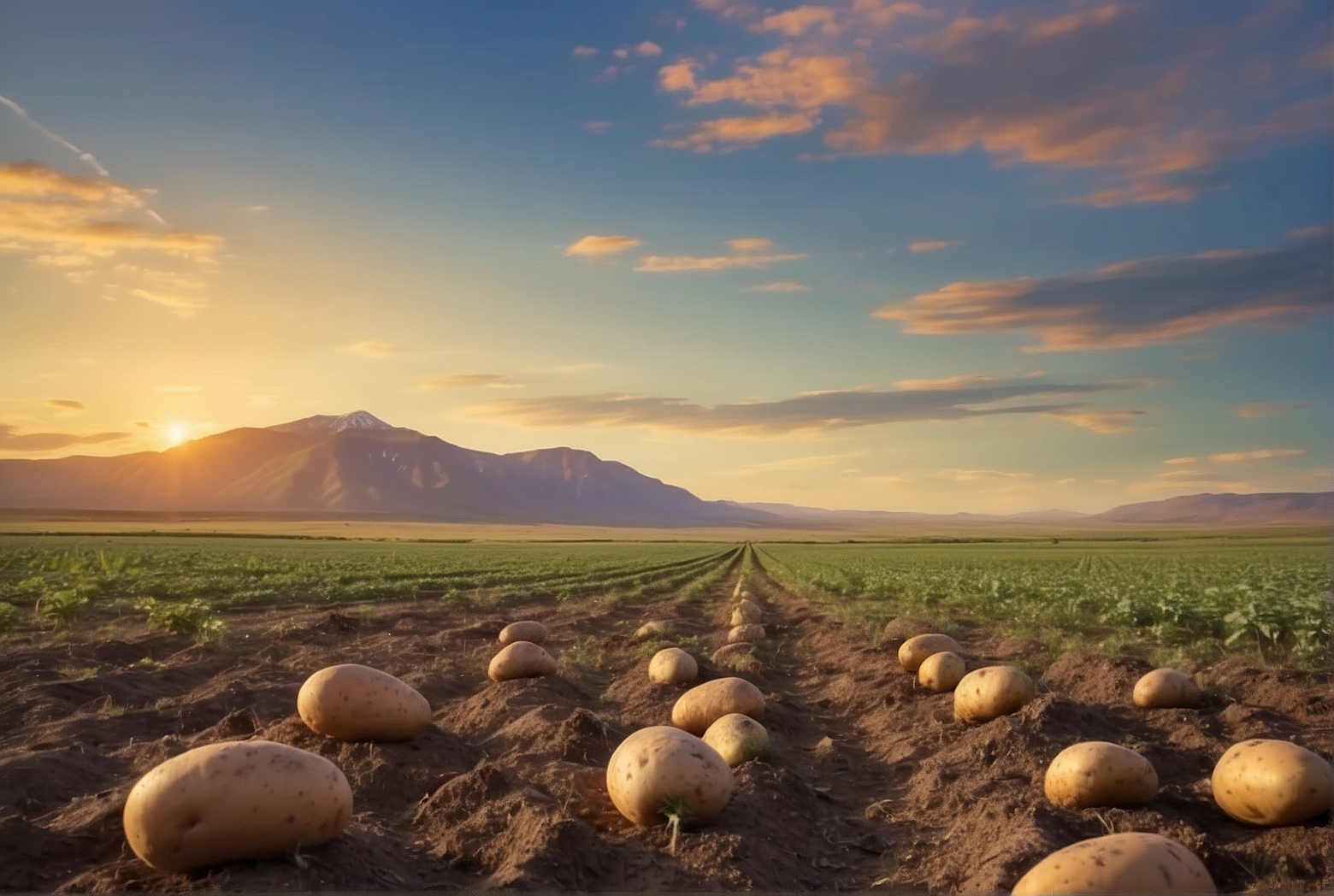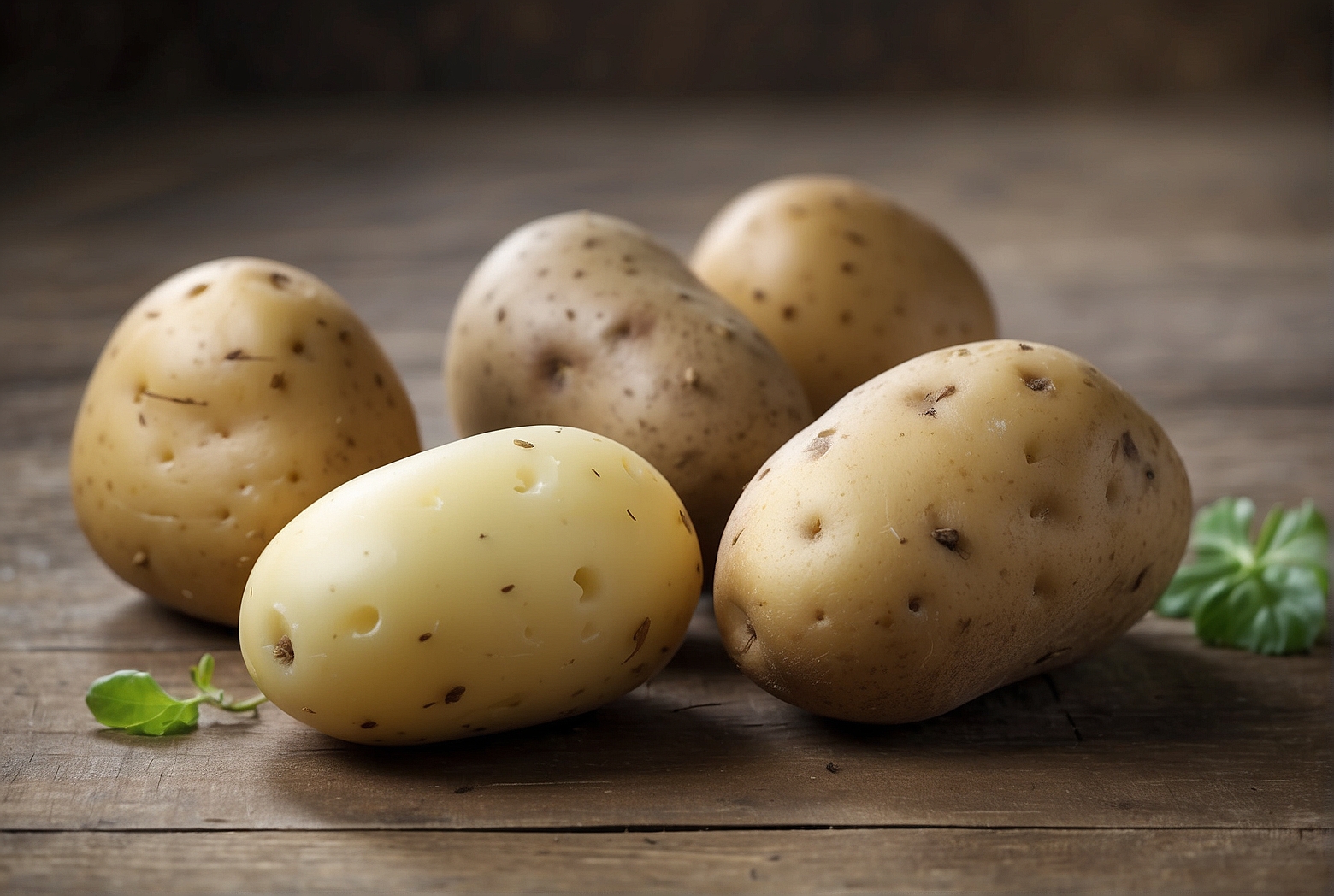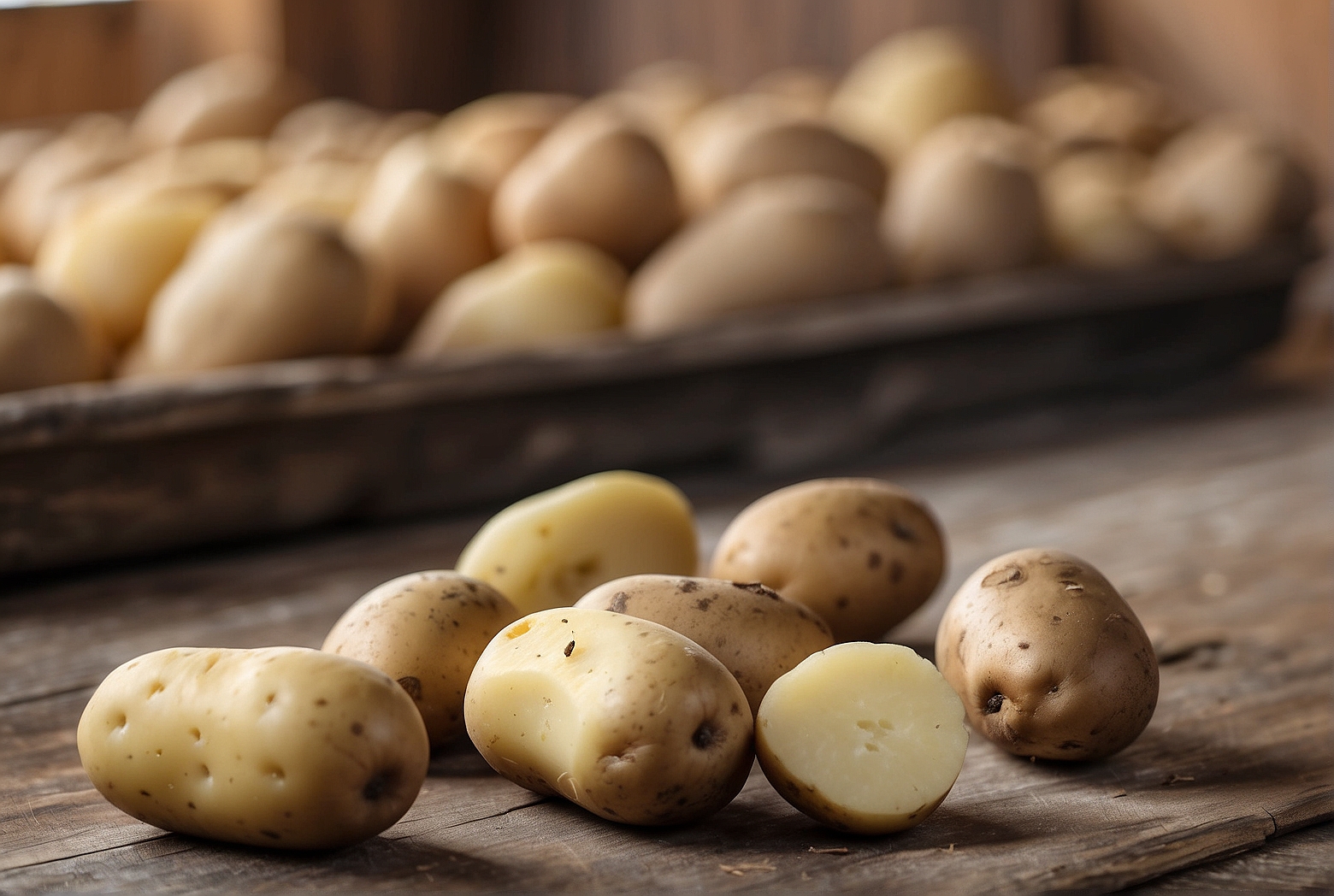Last Updated on April 4, 2024 by Tony Manhart
Are you curious to know whether Idaho potatoes are determinate or indeterminate? Well, you’re in the right place! In this article, we will explore the fascinating world of Idaho potatoes and shed light on their growth habit. Whether you’re a seasoned potato enthusiast or just someone who wants to learn something new, you’ll find this information both interesting and valuable. So, let’s dig into this spud-tacular topic and uncover the truth about Idaho potatoes!
Background of Idaho Potatoes
History of Idaho Potatoes
Idaho potatoes have a rich history dating back to the mid-19th century when they were first introduced to the region by settlers from Ireland. They quickly became a staple crop due to the fertile soil and ideal climate conditions found in Idaho. The state’s volcanic soil, combined with the cool nights and warm days, creates the perfect environment for growing high-quality potatoes. Over time, Idaho potatoes gained recognition for their superior taste, texture, and versatility, cementing their position as a top choice for consumers and producers alike.
Importance of Idaho Potatoes in Agriculture
The significance of Idaho potatoes in the agricultural industry cannot be overstated. Idaho is known as the “Potato State” for good reason, as it consistently ranks among the top potato-producing states in the United States. The state’s potato industry generates billions of dollars in annual revenue and provides jobs for thousands of individuals, both directly and indirectly related to potato cultivation. The popularity and demand for Idaho potatoes have led to the development of advanced farming techniques and technologies to maximize yields, enhance quality, and improve sustainability practices.
Varieties of Idaho Potatoes
Idaho potatoes encompass a wide range of varieties, each possessing its unique qualities and characteristics. Some of the most popular varieties include Russet Burbank, Russet Norkotah, Yukon Gold, and Fingerling potatoes. These varieties differ in terms of size, skin color, texture, and taste, offering consumers a diverse selection to suit their specific preferences and culinary needs. The versatility of Idaho potato varieties allows for their utilization in various dishes, ranging from crispy French fries and creamy mashed potatoes to hearty soups and flavorful casseroles.

Growth Characteristics of Idaho Potatoes
Idaho potatoes exhibit distinct growth characteristics that are essential to understand for successful cultivation. They are a cool-season crop that relies on specific temperature ranges for optimal growth. Idaho potato plants typically grow best in temperatures between 60 and 70 degrees Fahrenheit, with a preference for well-drained soil rich in organic matter. Additionally, Idaho potatoes have a shallow root system, which makes them susceptible to drought stress and requires regular irrigation. Understanding the growth characteristics of Idaho potatoes is crucial for farmers and gardeners to ensure proper care and maximize yield potential.
Determinate and Indeterminate Types
Definition of Determinate and Indeterminate Types
In the world of potatoes, determinate and indeterminate types refer to the growth patterns of the plants. Determinate potatoes are characterized by a fixed growth cycle, where the plant reaches a specific height and produces a set number of tubers before reaching maturity. Indeterminate potatoes, on the other hand, continue growing throughout their life cycle, producing new leaves, stems, and tubers as long as growing conditions are favorable.
Differences in Growth Patterns
The primary difference between determinate and indeterminate potato types lies in their growth patterns. Determinate potato plants grow in a more compact manner and tend to form bushy canopies. They exhibit a limited growth height, usually ranging from 18 to 24 inches, and set their tubers within a concentrated area close to the base of the plant. In contrast, indeterminate potato plants have a more open growth habit, with taller and more sprawling vines. Indeterminate varieties can continue producing tubers along the length of their stems, resulting in a more spread-out tuber distribution.
Factors Affecting Determinacy in Potatoes
Several factors impact the determinacy of potato plants. Genetic traits play a significant role in determining whether a potato variety is determinate or indeterminate. Environmental factors, such as temperature, light exposure, and nutrient availability, also influence the growth habit of potato plants. For example, cool temperatures and long day lengths tend to promote determinate growth, while warmer temperatures and shorter day lengths favor indeterminate growth. By understanding these factors, farmers can manipulate growing conditions to encourage the desired growth pattern in Idaho potatoes.

Idaho Potatoes Classification
Application of Determinate and Indeterminate Classifications
The classification of Idaho potatoes into determinate and indeterminate types serves several practical purposes. It helps farmers and gardeners choose the appropriate variety based on their available space, growing conditions, and intended use. Determinate types are often favored for smaller gardens or confined areas, as their compact growth habit requires less space. On the other hand, indeterminate varieties are suitable for larger areas where they can spread out and continue to produce tubers over an extended period. Additionally, classification aids in breeding programs and research, allowing for the development of new potato varieties tailored to specific needs.
Characteristics of Determinate Idaho Potatoes
Determinate Idaho potatoes possess unique characteristics that make them suitable for specific purposes. One key attribute is their synchronized tuber development, resulting in potatoes of similar size and maturity. This uniformity offers advantages during harvesting, as it allows for efficient mechanical harvesting and simplifies storage and processing. Determinate potatoes are also known for their early maturity, making them a popular choice for farmers aiming to extend their growing season or meet market demands for early-harvested potatoes.
Characteristics of Indeterminate Idaho Potatoes
Indeterminate Idaho potatoes exhibit characteristics that set them apart from their determinate counterparts. Their continuous growth and tuber production allow for an extended harvesting period, offering a prolonged supply of fresh potatoes. Indeterminate varieties are often favored by home gardeners and farmers who prioritize a continual harvest or desire a steady supply of potatoes for fresh consumption throughout the growing season. Moreover, indeterminate potatoes tend to demonstrate greater resilience in the face of environmental stresses, such as drought or disease, making them a viable option for areas with challenging growing conditions.
Growth Cycle of Idaho Potatoes
Sprouting Stage
The growth cycle of Idaho potatoes begins with the sprouting stage, typically occurring in early spring. During this stage, the potato tubers start to develop sprouts or “eyes” in response to favorable soil temperatures and moisture levels. The sprouts emerge from the tubers and develop into stems and leaves, initiating the vegetative growth stage.
Vegetative Growth Stage
The vegetative growth stage is characterized by the rapid growth of potato plants’ foliage. The stems and leaves increase in size, utilizing sunlight and nutrients to fuel their development. This stage is crucial for building a strong and healthy plant structure, allowing the potato plant to capture maximum sunlight for photosynthesis, which in turn supports tuber development.
Flowering Stage
As the vegetative growth stage progresses, potato plants eventually reach the flowering stage. During this phase, the plants produce clusters of small white or purple flowers atop the leafy stems. While the flowers themselves are not a significant part of the potato plant’s reproductive process, they indicate that tuber formation is underway.
Tubers Formation Stage
The tubers formation stage is a critical period in the growth cycle of Idaho potatoes. It occurs after the flowering stage when the plant directs its energy towards tuber development. Underground, the stems of the potato plant enlarge and play a vital role in producing tubers. As the stems thicken, they begin to develop stolons, which are horizontal underground branches that give rise to the formation of tubers along their length.
Tubers Maturation Stage
The final stage in the growth cycle of Idaho potatoes is the tubers’ maturation stage. It occurs when the tubers reach their full size and develop the desired characteristics specific to each variety. Potatoes undergo physiological changes during this period, transforming from immature tubers to mature ones suitable for consumption or further processing. The length of the tuber maturation stage varies depending on the potato variety and environmental factors, such as temperature and soil moisture.
Methods to Identify Determinacy in Potatoes
Visual Observation
Visual observation is one of the simplest methods to identify the determinacy of potato plants. Determinate potato varieties tend to have a more compact growth habit, shorter stems, and a concentrated distribution of tubers near the plant’s base. Indeterminate potato varieties, on the other hand, exhibit a more sprawling growth habit, longer stems, and tubers distributed along the length of the vines. By carefully observing the plant’s growth pattern and tuber development, one can make an educated assessment of its determinacy.
Growth Habit Assessment
Assessing the growth habit of potato plants is another effective method to determine their growth type. Determinate potato plants tend to exhibit a more bushy or mounded appearance due to their limited growth height. The foliage is concentrated close to the ground, and the canopy is fuller and more compact. Indeterminate potato plants have a more sprawling growth habit, with vines that spread out and grow longer over time. By evaluating the overall growth habit, one can infer the determinacy of the potato variety.
Genetic Testing
Advances in genetic testing have provided a more accurate and efficient means of identifying the determinacy of potato plants. Scientists can analyze the genetic makeup of a potato variety to determine whether it carries the genes responsible for determinate or indeterminate growth. This method is particularly valuable in breeding programs, allowing breeders to select and develop potato varieties tailored to specific growth patterns, yield potentials, and environmental adaptability.
Advantages of Determinate Idaho Potatoes
Uniform Harvesting
One of the key advantages of determinate Idaho potatoes is their synchronized tuber development, leading to a more uniform harvest. Since determinate varieties set a specific number of tubers in a concentrated area, farmers can predict and plan for a consistent harvest timeline. This uniformity facilitates mechanical harvesting operations, as the tubers are of similar size and maturity, allowing for efficient collection and processing.
Ease of Cultivation
Determinate Idaho potatoes are generally easier to cultivate compared to their indeterminate counterparts. Their compact growth habit requires less space and allows for closer planting distances. This efficiency in space utilization is particularly advantageous for farmers with limited land availability or those aiming to maximize their yields within a confined area. The ease of cultivation associated with determinate varieties contributes to reducing labor and production costs.
Higher Yield per Plant
Determinate Idaho potatoes often exhibit higher yield potentials per plant compared to indeterminate varieties. Due to their synchronized tuber development and concentrated tuber distribution, determinate potatoes can allocate the plant’s resources more efficiently, resulting in larger and more abundant tubers. This higher yield potential allows farmers to increase their overall production and meet market demands for potatoes.
Advantages of Indeterminate Idaho Potatoes
Extended Harvesting Period
Indeterminate Idaho potatoes offer the advantage of an extended harvesting period. As these varieties continue to produce tubers along the length of their stems, new tubers can be harvested while leaving the remaining plants undisturbed. This continual harvest allows for a steady supply of fresh potatoes over a more extended period, satisfying consumer demands and reducing the need for storage. Home gardeners and farmers who prioritize a continuous supply of fresh potatoes throughout the growing season often favor indeterminate varieties.
Greater Tuber Production
Indeterminate Idaho potatoes have the potential to produce a larger number of tubers compared to determinate varieties. The continuous growth and tuber formation along the stems result in a greater total tuber production outcome. This increased tuber yield can be beneficial for commercial potato growers aiming to maximize their harvest and meet market demands. Additionally, having a larger number of tubers can offer more flexibility in terms of sorting, grading, and distributing potatoes based on size and quality.
Resistance to Environmental Stresses
Another advantage of indeterminate varieties is their inherent resistance to environmental stresses. These potatoes exhibit a resilience that allows them to tolerate various challenges, such as drought, high temperatures, and disease pressures. The continuous growth and tuber formation provide a buffer against adverse conditions, ensuring that even under challenging circumstances, the plants can continue producing tubers. This resistance to environmental stresses makes indeterminate Idaho potatoes a reliable choice for growers facing unpredictable or harsh growing conditions.
Challenges Faced with Determinate and Indeterminate Potatoes
Storage and Shelf Life
Both determinate and indeterminate Idaho potatoes face challenges related to storage and shelf life. Proper storage conditions, such as controlled temperature and humidity levels, must be maintained to minimize tuber sprouting, deterioration, and loss of quality. Determinate potatoes, with their synchronized tuber development, tend to have a shorter shelf life compared to indeterminate varieties. However, advances in storage technologies and post-harvest handling practices have enabled longer storage periods for both types, enhancing their marketability and availability year-round.
Pest and Disease Management
Potato crops, regardless of their determinacy, are susceptible to various pests and diseases that can significantly impact yield and quality. Common potato pests include aphids, potato beetles, and nematodes, while diseases like late blight, early blight, and potato viruses pose significant threats. Both determinate and indeterminate potatoes require diligent pest and disease management strategies, including regular monitoring, timely application of appropriate pesticides or biocontrol methods, and crop rotation practices to minimize the risk of infestations and disease outbreaks.
Environmental Adaptability
Determining and indeterminate Idaho potatoes both face challenges related to environmental adaptability. Each type has its specific preferences and tolerances when it comes to temperature, humidity, soil conditions, and light exposure. It is crucial for farmers to select the appropriate potato variety for their specific growing conditions to ensure optimal growth and yield. Climatic factors, such as extreme temperatures, excessive rainfall, or prolonged droughts, can pose challenges for potato cultivation, necessitating adjustments in farming practices and the adoption of suitable mitigation strategies.
Commercial Applications of Idaho Potatoes
Processing for Food Products
Idaho potatoes play a critical role in the processing industry, serving as a primary ingredient in a wide array of food products. The high starch content and desirable texture of Idaho potatoes make them ideal for processing into products like French fries, potato chips, dehydrated potato flakes, and mashed potato mixes. The uniformity and quality of determinate Idaho potatoes are particularly advantageous for processing applications, ensuring consistent taste, texture, and appearance in the final food products.
Fresh Consumption
Idaho potatoes are highly prized for their exceptional taste and versatility, making them a popular choice for fresh consumption. Whether baked, boiled, mashed, or roasted, Idaho potatoes deliver a delicious and satisfying culinary experience. Determinate and indeterminate varieties alike offer consumers the opportunity to enjoy the natural flavors and unique characteristics of Idaho potatoes in a wide range of dishes.
Seed Production
Idaho’s reputation as a premier potato-growing region extends to seed production as well. Seed potatoes, which are specially grown and certified for planting, play a crucial role in maintaining the quality and health of potato crops. Determinate and indeterminate Idaho potatoes are grown for seed production, ensuring a reliable and consistent supply of high-quality planting material for farmers across the country. The robustness and adaptability of Idaho potatoes make them excellent candidates for seed production, leading to the establishment of a thriving seed industry within the state.
Conclusion
Summary of Determinate and Indeterminate Types
In summary, Idaho potatoes come in both determinate and indeterminate types, each with its unique growth characteristics. Determinate potatoes exhibit a compact growth habit, synchronized tuber development, and early maturity, offering advantages such as uniform harvesting, ease of cultivation, and higher yield per plant. Indeterminate potatoes, on the other hand, display continual growth and tuber production, with benefits including an extended harvesting period, greater tuber production, and resistance to environmental stresses.
Importance of Identifying Growth Characteristics
Identifying the growth characteristics of Idaho potatoes is vital for farmers, gardeners, and consumers alike. Understanding the determinacy of potato varieties enables individuals to make informed decisions regarding cultivation practices, planting arrangements, and harvesting schedules. Furthermore, it assists researchers and breeders in developing new varieties tailored to specific needs and market preferences.
Considerations in Choosing Idaho Potatoes for Cultivation
When choosing Idaho potatoes for cultivation, several factors should be considered. Determinate varieties are well-suited for smaller gardens or confined spaces, while indeterminate varieties are ideal for those seeking an extended harvest or facing challenging growing conditions. Environmental factors, such as temperature ranges and light exposure, should also be taken into account to ensure optimal growth and yield. By selecting the appropriate variety, farmers and gardeners can maximize their productivity and enjoy the exceptional taste and quality for which Idaho potatoes are renowned.
Tony Manhart is a passionate gardener who has been tending to gardens for over 20 years. He takes pride in creating beautiful outdoor spaces with plants, trees, and shrubs that can thrive in any environment. He loves to share his knowledge with others and has taught classes on gardening basics and advanced techniques. He is committed to sustainability, using natural and organic methods to create and maintain gardens. He also works with local organizations to create green spaces for communities. When he’s not gardening, Tony enjoys hiking, reading, and spending time with his family.


